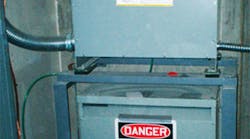Most petrochemical industrial facilities have numerous small (30kVA or 45kVA) transformers spread throughout the process units serving lighting and power distribution panelboards. In the U.S., the typical scenario is the transformers are fed on the primary side with a 480VAC, 3-phase circuit and stepped down to feed 208Y/120VAC, 3-phase at a panelboard. The 480V primary overcurrent protective device (OCPD) is either a thermal magnetic breaker or a set of fuses. It’s also common to see a main breaker for a secondary OCPD (main circuit breaker) installed in the panelboard for transformer secondary protection.
The 2014 Edition of the National Electrical Code (NEC), Table 450.3(B), indicates the maximum rating or setting for primary and secondary OCPDs. For example, a 30kVA step-down transformer, rated 480V-208/120V, 3-phase with primary and secondary OCPDs sized per Table 450.3(B), has a maximum rating of 250% of the primary side current where secondary protection is provided. Therefore, we size the protective device as follows:
30,000VA ÷ (480V x 1.732) = 36A x 2.5 = 90.2A
Based on this result, we know a maximum 90A circuit breaker or set of fuses could be used for the primary OCPD.
The reason this high current rating is allowed is to compensate for transformer inrush (winding saturation) currents, which, in some cases, can be more than 20 times the normal primary current rating of the transformer for a few milliseconds.
Some engineers or electricians use 125% of the normal primary current rating of the transformer when sizing the primary OCPD, without considering the inrush current. In this case, it would result in using a primary OCPD rated at 45A.
30,000VA ÷ (480V x 1.732) = 36A X 1.25 = 45A
In this case, there’s no Code violation if using a 45A breaker or fuse. But, as the Code states in Sec. 90.1, the provisions of the Code are provided for safety and not intended as a design specification. One should go a step further when sizing the primary OCPD and check the time-current curves for the OCPD in coordination with the transformer to make sure there won’t be nuisance tripping of the breaker or an occasional blown fuse when energizing the transformer when sizing the primary OCPD at 125% of the full current rating of the transformer. Depending on the transformer and where the primary OCPD closes in the sinusoidal cycle, it’s very possible that a 45A breaker or fuse may trip or blow, respectively.
I don’t advocate using the maximum allowable 250% multiplier in every case. Doing so increases wire and conduit sizes, which in the end drives up costs. But blindly using a 125% multiplier, without checking the inrush currents and the time-current curves for the OCPD, may result in unsatisfactory performance. It’s been my experience that the ideal rating for the primary OCPD usually lies somewhere between 125% and 250% of the full load current rating of the transformer.
The bottom line: Sizing the primary OCPD should be looked at closely during the design phase of a project to reduce a potential nuisance tripping problem during operation of the system.
© 2015 Fluor Corporation. All Rights Reserved.



